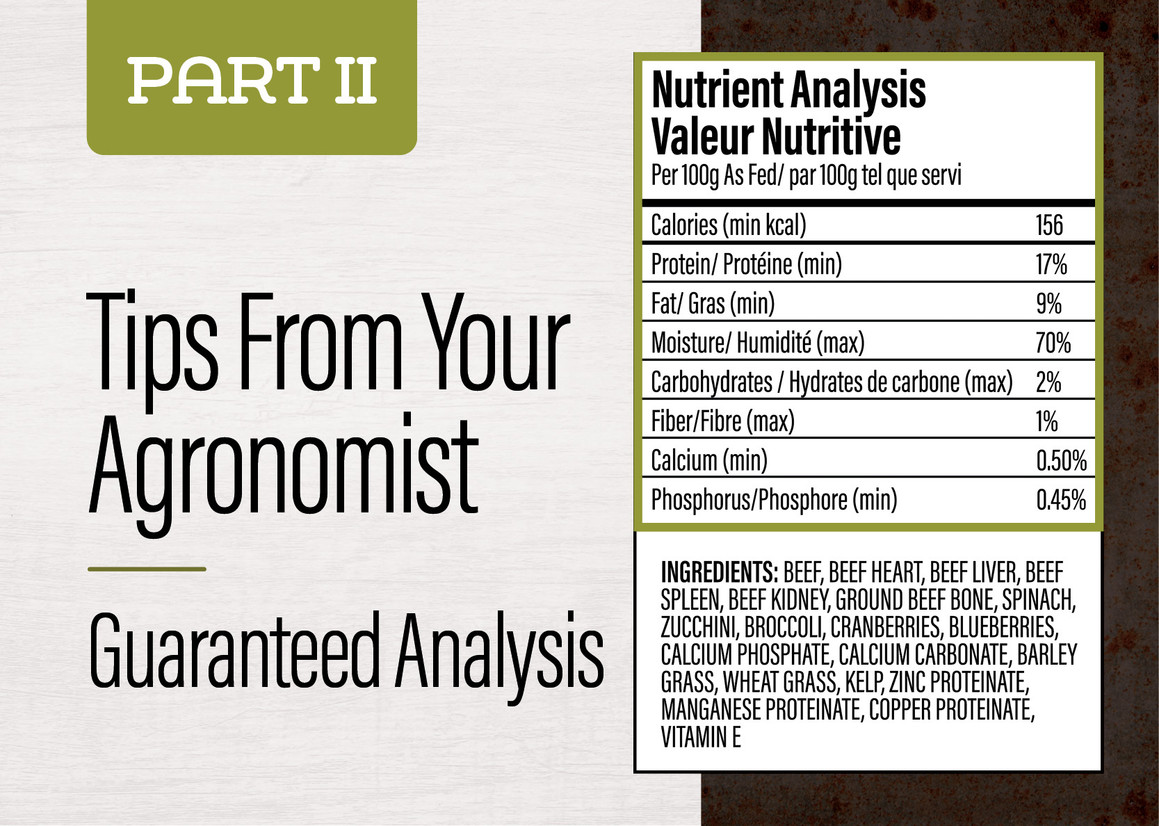How to Read Pet Food Labels – Part II: Guaranteed Analysis
As mentioned in Part I, something that I particularly enjoy doing is going through the nutrient and ingredient panel of pet food. When you know what to look for, it can be impressive the amount of information you can find – from the nutrient value of the food to the transparency of the brand, you can find it all! It is very easy to hide information or use marketing to make a food look good, but numbers can’t lie if we know how to read them. Let me give you some tips…you might never see a nutrient label the same way.
For information on how to read the ingredient list, please see Part I. Now, we will talk about the information you can find on a pet food nutrient label. For some, this list is very short. In fact, only protein, fat, moisture and fiber are mandatory.
CRUDE PROTEIN
The crude protein number doesn’t give us a lot of information, especially for kibble (where a significant part of the protein can be plant-based). In fact, the total protein number found on a pet food label is simply the amount of nitrogen in the food multiplied by a factor associated to the nitrogen content of protein. In an extreme case, a brand could even add urea in pet food to increase the crude protein content (urea is authorized for feed and is a non-nutritional source of nitrogen in food and pet food). Urea is the water-soluble form of nitrogen, if has no nutrition benefit and is the waste form of nitrogen that our bodies use to prevent nitrogen intoxication – excreted by urine. Total crude protein is just a reflection of the nitrogen content of the food. If a brand shares the amino acid profile, it at least shows their understanding of how crude protein isn’t very useful. Total crude protein on its own is not very useful to determine the quality of the food – we also need to use the ingredient list and watch for fractioning of ingredients (See Part I), as well as use the other guaranteed analysis numbers presented below.
FAT
It is a bit harder to mislead the fat content of a pet food than it is for protein, but total fat, just like protein, does not show the quality of the fat – but at least we can be sure that fat is fat. The ingredient list will be most helpful in evaluating what type of fat is included – plant and fish oil will mostly bring unsaturated fat, while chicken and farmed animal fat will bring saturated fat. Both are essential and are the best source of energy for dogs and cats. Fat is also essential in absorption and metabolism of many essential nutrients. Dogs and cats need a moderate to high fat diet. Diets that are extremely low in fat and higher in carbs will put more pressure on the metabolism. Studies even demonstrate that for weight management, dogs and cats do better on a high protein, moderate fat and low carb diet than typical high fiber/carb light diets. Be careful of extruded diets with high fat and oil inclusion; the high temperature cooking will probably change the fatty acids’ profile of the fat, and sensitive fatty acids like omega-3 will likely be destroyed and need to be added back in at time of feeding.
MOISTURE
Moisture refers to the amount of water in the food, and is another component we often forget to look at when examining pet food labels. Moisture can hide many things, but don’t get me wrong – water in pet food can be great. In fact, even big kibble brands now mention on their feeding guidelines to re-hydrate food before serving! A normal diet should always include water and moisture within the food. Kibble is dry and the amount of water is usually under 10%. Raw is fresh and is usually between 60-70% water. Canned food takes it to the limit, with water content often over 80%.
Moisture is why protein and fat are always lower in raw and canned food compared to kibble. Per gram of food, there is a larger proportion of water. In terms of dry matter ingested, raw is much higher in both.
Water can sometimes act as a filler, this is why for some canned foods the recommended feeding amount is insanely high. Since raw diets are so nutritious with a large proportion of meat, you get the best of both worlds: less food to give and high moisture content.
CRUDE FIBER AND CARBS
There is another way the pet food industry reduces calories to make you buy more food: plant-based fillers. Even though some vegetable ingredients can bring incredible nutrients to your dog, such as phytonutrients and antioxidants, less is more.
Crude fiber is not the total carbohydrate content of the food. Fiber, by definition, is not always carbohydrate-based since it can also have components like lignin and pectin. A general definition of fiber is: resistant to digestives enzymes (except for certain soluble fibers that are digestible by specific gut bacteria enzymes). Starch, glucose, fructose, etc. are not included in the crude fiber number. In fact, unless a company willingly shows the carbohydrate content of the food, it is often hidden. Fun fact: animal ingredients bring very little carbs (mostly under the form of glycogen – the sugar reserve of animal) and are usually less than 1-3% of the nutrient analysis depending on the protein and organs (duck and liver being especially high in carbs). Carbs come from plants, so the carb level of food is usually a very good indication of the proportion of plant in a pet food. If there’s food that is supposed to be 100% animal ingredients, and you see a % of fiber, then we have a problem.
Determining Carbohydrates and Proportion of Vegetables in a Pet Food
/blog/how-to-read-pet-food-labels-part-i-the-ingredient-list/
The Calculation is Simple:
100% – Protein % – Fat % – Fiber % – Moisture % (water) – Ash % (total of vitamins & minerals) = % of carbs (starch & sugar).
So now, if a company wants to hide the amount of carbohydrates from you, you now know how to find that number. Just like for crude protein, the total amount of carbs is very vague and says nothing about quality of the carbs. That’s when we need to refer to the ingredient list and find the glycemic index of the fruits, vegetables, grains used, oilseed and protein plants (like soy and peas). As a reminder, the glycemic index is the impact an ingredient has on blood sugar levels. The higher the glycemic index, the more blood sugar will rise after digestion, which is something we want to avoid.
Another trick to find the proportion of vegetables in a food if the company doesn’t list it, is to keep in mind the carb to protein ratio. For example, each gram of peas brings 5% protein and 15% carbs – so for each % of protein coming from peas in a pet food, 3% of carbs is also added. This ratio is big for some commonly used plant ingredients (protein:carbs ratio). Here are some examples of protein:carbs ratios:
Corn = 1:6
Oat = 1:5
Pumpkin = 1:6
Squash = 1:10
Spinach = 1:1
Broccoli = 1:2
Muscle Meat = 20:0
Liver = 5:1
So, the higher carb %, the more plant-based material in the food, and thus more chance the protein is coming from plants. It is easier to increase the % of protein in a food with protein plants like peas, chickpeas and lentils. That is a kibble marketing scam! The food looks high in protein and low in carbs, compared to other food, but the quality of the protein isn’t any better. When you notice that there seems to be a very high proportion of protein plants in the ingredient list (See Part I for details on how to figure that out), the only thing you can do is ask the company for the proportion of protein coming from meat.
When raw diets first began it was common to see the inclusion of 10% fruits and vegetables as the ideal ratio. Now, some raw foods on the market have as high as 25% fruits and vegetables added! This greatly reduces the number of calories and often increases moisture as well – so the feeding amount is higher. Some brands even choose not to share the proportion of vegetables in the recipe. To make sure you are not feeding a raw diet full of filler, you can use the same calculation shared above for kibble and canned food.
To use as a guideline, on an as fed basis (because raw food analyses are often shared as fed, so with water included around 65-70%) – for each 2% of carbs analyzed you can estimate 5% vegetables in the recipe.
If a raw diet is 15% protein, 10% fat, 1% fiber, 65% water and approximately 2% ash, that means there is 7% carbs. That means 35% fruit and vegetable inclusion.
Sometimes, you will find very weird things when trying to calculate the carb content of a food. Things like, a number higher than 100% when protein, fat, fiber, and moisture are added. This is despite the fact there is supposed to be ash and carbs as well. Other times, when you add all the numbers you will get at a total lower than 90%. What does that mean? Well, it means that there is something wrong with those numbers- maybe the min and max has been exaggerated to make the food look better, maybe those numbers come from multiple lab analyses and only the best numbers were taken. The best thing to do in those situations is to reach out to the company and ask for an explanation as to why the percentages don’t add up!
Using Calories to Proof Numbers
Another way of knowing if the numbers that are shared have been edited to look better (because there really are no regulations), is to calculate the calories based on the nutrient categories. The easiest and quickest way is to use these multipliers: each gram (or %) of protein brings 4 kcal, carbs (without fiber) 4 kcal and fat 9 kcal.
For example, a raw diet with 16% protein, 10% fat and 2% carbs will bring approximately 162 kcal per 100g of food as fed (water included). If the number of calories listed on the label is much lower or much higher than that, it means they might not be accurate.
To learn how Big Country Raw nutrient labels and guaranteed analyses are created, be sure to read our blog: The Secrets Behind Big Country Raw’s Food Formulation – Coming Soon!
Recent Posts
-
Fire Safety for Dog Owners
We’re honoured to welcome Fire Chief Dave Upper of St. Catharines, Ontario, as a guest co
-
Ahiflower: A new earth-friendly Omega choice
Fish oils are a formidable and essential component of a pet’s diet, benefitting skin and coat
-
Hydration Matters
Why Your Pet May Still Be Dehydrated (Even with a Full Water Bowl) Hydration is probably one o





